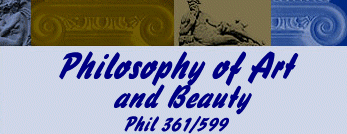











DUE: Wednesday, May 13, 12:00 noon Pacific Daylight Time
LENGTH: 600-1000 words (ordinarily, this would print out to 3-5 pages, double-spaced, with normal margins and type sizes)
HOW TO SUBMIT YOUR PAPER: Please submit your paper as a file attached to an e-mail message. Step-by-step instructions are available on-line by clicking here.
When you name the file on your paper, please give it a name distinctive to you: e.g., smith.wp or jones.doc Please do not name it Paper or 361 or a name others in the class are likely to use. The extension on your file name (the last three letters to the right of the period) should indicate the word-processing program you are using (.wp = WordPerfect, .doc = Word, .txt = text, etc.)
CONTENT: Please pick one (and only one) of the questions on the list below (#1-4). Please do not do any outside research beyond the assigned reading in the question you choose, including the discussion questions, the hyperlinks in the readings and questions, and the class on-line discussion of those readings.
- "The Picture of Dorian Gray" by Oscar Wilde: Put yourself in Wilde's Theoretical "shoes." Now consider Plato's "The Republic" (Book X). identify the passages with which you, as Wilde, most strongly disagree and explain your disagreement in detail.
- "Of the Standard of Taste" by David Hume: Assess the strengths and weaknesses of Hume's proposals concerning our aesthetic judgments. Discuss at least two examples from our experience of art which explained well by Hume's theories and two examples from our experience of art which are counter-examples to Hume's theories.
- Using the materials on the site, "Freedom of Expression at the National Endowment for the Arts," Section One: http://www.csulb.edu/~jvancamp/freedom1.html, analyze this problem: Some years ago, on an eastern college campus, flyers were distributed with the names of male students randomly drawn from the student directory, with the label that they were "potential rapists." Assume that this is guerrilla theater art. Were these flyers statements? Were they false statements? Were the reputations of the male students harmed? Should these expressions be protected by the First Amendment if the expressions were made by artists? Should we allow such statements, even if they are defamatory, if they were made by artists? How should we decide who counts as an artist for this exception to the prohibition on defamation?
- Using the materials on the site, "Freedom of Expression at the National Endowment for the Arts," especially Section Three: http://www.csulb.edu/~jvancamp/freedom3.html, discuss whether or not the NEA should fund these projects (consider both the pros and cons of government funding): (A) a proposal for a theater production supporting Ku Klux Klan values, (B) a proposal from a member of the Nazi party to educate the public about the Nazi viewpoint, (C) a proposal from a group which denies that the Holocaust ever happened, (D) a proposal from a budding rap group with lyrics in the group's songs that encourage violence toward women.
WHICHEVER QUESTION YOU CHOOSE: In our class discussions, we have worked on elements of good reasoning: e.g., clarifying terminology, looking for supporting examples and counter-examples, making explicit the assumptions which are implicit and perhaps questionable. Your essay should demonstrate your development of these good reasoning skills. Your essay should also explicitly use the ideas in the article by the philosopher/theorist you choose.
Your essay should adhere to good standards for composition. Check spelling, grammar, and punctuation.
Grading will consider the comprehensiveness of your discussion, the range of reasons discussed, your demonstrated and detailed understanding of the material in Unit II (the writer you select and the reasoning skills we have worked on throughout the unit), and the variety of properties of the art that you explore.
GRADING: This paper is worth up to 12 points
ASSIGNMENT OF POINTS:
LATE PAPERS: Late papers will be accepted for up to 48 hours after the deadline, but will receive an automatic 4 point deduction. No papers will be accepted after May 15, 12:00 noon PDT.
TECHNICAL EMERGENCIES: Please plan ahead. The Internet is full of surprises, not all of them happy ones.
- Don't wait until the last minute to look at the Web sites for the assignment - they might be off-line just when you need to see them.
- Please don't wait until the last minute to figure out how to send the paper as an e-mail attachment. If you want to, you can send me a near-final draft a few days ahead, just to be sure it's in on time, and send me your final version by the deadline.
- If you have a technical emergency beyond your control on the day of the deadline, you can meet the deadline by faxing a print-out of your paper to the department fax: (562) 985-7135, but you must still send me your paper as an e-mail attachment as soon as possible - preferably the next day. This option should be reserved for extraordinary emergencies.
- If we have a major disaster on the Long Beach campus that knocks out the entire computer system or electrical power (El Nino flooding? 7.0 earthquake?), I will obviously extend the deadline until we're back on line.
